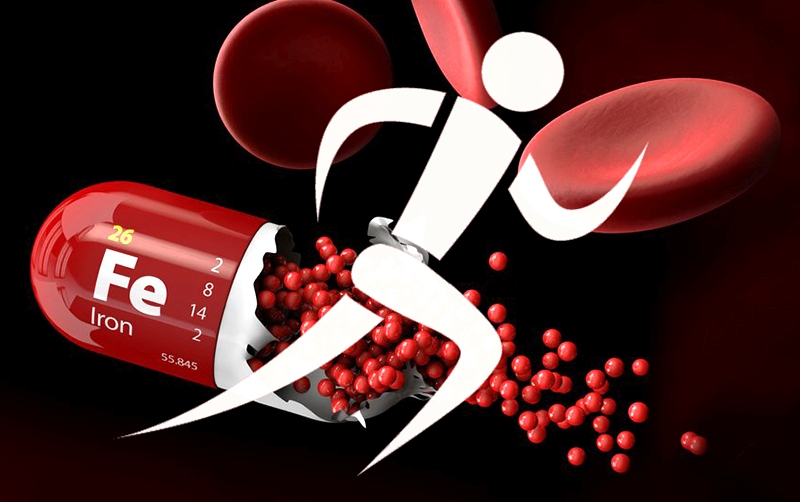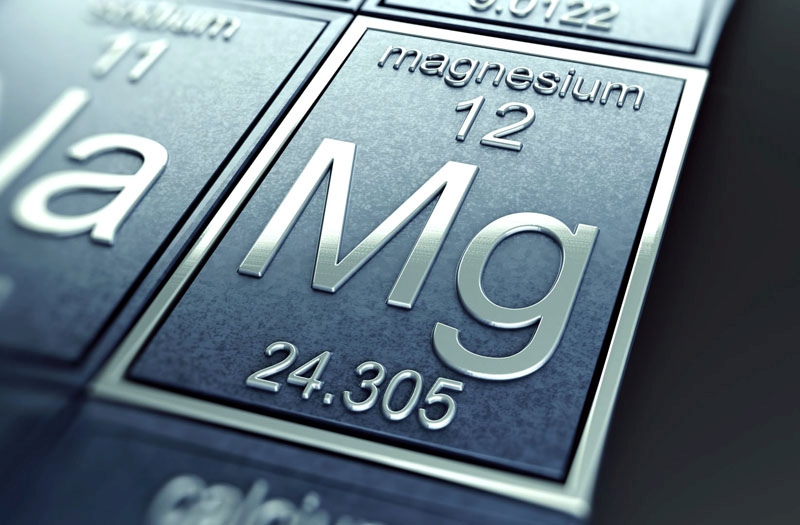You are viewing 1 of your 1 free articles. For unlimited access take a risk-free trial
Chromium: steel yourself with the mysterious mineral

How important is chromium for human health, and can athletes benefit from chromium supplementation? Andrew Hamilton explains why there’s still much mystery surrounding this ultra-trace mineral, and what athletes need to know about optimising their intake
Pure chromium is a steely-grey metallic element found naturally in the Earth’s crust at an average concentration of 100 parts per million (ie around 1 gram in every 10kgs), making it the 13th most abundant element on the planet. Most naturally occurring chromium is in the form of an ore called ‘chromite’, from which pure chromium is extracted. Industrially, chromium has many uses but probably the most familiar to most people is that it is added in small amounts to iron to make stainless steel, thereby preventing rust formation.Why do we need chromium?
In certain organic forms, chromium is an essential mineral for human health (but see panel below). Chromium is known to enhance the action of insulin(1-3), a hormone critical to the metabolism and storage of carbohydrate, fat, and protein in the body(4). Importantly, it is required for the synthesis of a molecule called ‘glucose tolerance factor’ (GTF), which helps the hormone insulin – used to regulate blood sugar and energy levels in the body - to work more effectively in the body(5). Chromium also appears to be directly involved in carbohydrate, fat, and protein metabolism, but more research is needed to determine the full range of its roles in the body.The two sides of chromium
It’s important to understand that chromium exists in two forms; as trivalent and hexavalent ions. Naturally occurring chromium found in the human body and the foods we eat is almost always present as trivalent chromium. This is a chromium atom with three electrons missing – ie carrying a +3 positive charge. However, another and much more chemically reactive form of chromium is produced for use in various chemical and industrial processes. This is hexavalent chromium, with 6 electrons missing - ie carrying a +6 positive charge – the most common compound being sodium dichromate. Hexavalent chromium is harmful to the eyes, skin, and respiratory system, and research suggests that all chromium +6 compounds are potentially carcinogenic. When we talk about chromium in a nutritional context, we always mean trivalent chromium!Where can I find chromium?
The best dietary sources are meats and fish (eg beef, chicken, liver and oysters) and unrefined whole grains such as wholemeal bread and whole grain cereals. Fruits and vegetables are generally unreliable sources of chromium, while refined foods, especially those containing sugar are very poor sources of the mineral. Cooking or preparing foods using stainless steel utensils may add significant amounts of chromium to the diet.The caveat to all of the above is that the chromium content in foods is substantially affected by soil levels and agricultural and manufacturing processes. Moreover, due to the very low levels typically present, an accurate analysis of chromium content is difficult to achieve. This means that tables showing typical chromium levels in various foods should not be taken as gospel, but rather more as just a guide.
How much chromium do you need?
Because of the difficultly in identifying the precise biochemistry of chromium in the human body, and levels at which deficiency symptoms appear, there is more uncertainty about the optimum daily intake recommendation than with most nutrients. However, authorities in Australia and New Zealand recommend that adults males should consume 35 micrograms (mcg - a microgram is a millionth of a gram) of chromium per day, while females should consume 25mcg per day(6). The same is true in the US, where the guidelines were drawn up with the help of previous data derived from measuring the typical chromium content of 22 different, well-balanced nutritious diets(7).Who can benefit from increasing their dietary intake of chromium?
In theory, anybody who regularly consumes significant amounts of sugary and/or refined foods (eg white rice and white flour products) could benefit from extra chromium. Even very well balanced diets prepared by dieticians typically contain only around 30mcgs of chromium per day; if sugar and refined carbohydrate make up a significant proportion of the calories consumed, it becomes very unlikely that chromium intake will be adequate. Furthermore, research has also established that diets high in simple sugars (comprising more than 35% of calories) can actually increase chromium excretion in the urine(8). For these reasons, reducing your intake of sweet/sugary foods and switching to wholemeal/wholegrain breads/rice/cereals is an essential part of improving your chromium status.Some research suggests that older people have lower chromium levels in the body, which suggests that ensuring adequate chromium intake might be more important as we age(9). Because chromium deficiency impairs the body’s ability to use glucose to meet its energy needs and raises insulin requirements, many researchers have suggested that those with diabetes or with family members who suffer from diabetes should also pay particular attention to this nutrient.
Despite the above, the research on the link between poor insulin response/diabetes and chromium is far from clear. For example, a large review study (a study that summarises data from a number of previous studies) looked at the benefits or otherwise of providing extra chromium in the form of supplements to adults with impaired glucose tolerance or full-blown type-2 diabetes(10). In 14 out of the 15 studies, chromium supplementation had no effect on glucose or insulin concentrations. In the 15th (conducted in China), there were clear benefits, but the study participants were already known to be chromium deficient. This suggests that unless there is a clear chromium deficiency, there are unlikely to be any benefits relating to insulin metabolism by taking chromium supplements.
However, much more recent research suggests that there IS a relationship between chromium levels in the body and insulin function. In a 2017 study, researchers looked at the chromium status of 4443 patients(11):
- *1471 newly diagnosed type-2 diabetes patients
- *682 newly diagnosed pre-diabetes patients (ie with poor glucose tolerance but not full-blown diabetes)
- *2290 individuals with normal glucose tolerance (ie healthy)
Chromium and advice for athletes
Do athletes have any special chromium requirements? Athletes who train hard and long will typically be consuming large amounts of carbohydrate for fuelling their workouts and recharging muscle glycogen (stored carbohydrate). Because of the role of chromium in optimising insulin, an adequate chromium intake is important. A properly functioning insulin system helps ensures that muscle glycogen can be replenished efficiently following workouts. It also helps to stabilise blood sugar, which reduces the chance of energy swings and troughs, and also makes sweet/sugar cravings less likely to occur! Insulin is also one of the body’s most important anabolic hormones. During the recovery period after exercise, insulin helps drive not only glucose into muscle cells (to replenish muscle glycogen), it also enables the transport of amino acids into cells, which helps rebuild and repair muscle tissue, which is inevitably damaged after exercise.We know that insulin function is compromised by excessive levels of body fat and also sedentary lifestyles. For this reason, it’s fairly unlikely that endurance athletes will go onto to develop serious clinical problems linked to poor insulin function such as type-2 diabetes. However, athletes who consume large amounts of refined carbohydrates in the form of energy drinks, gels and bars should be aware that these products generally contain very little if any chromium. If you are a regular user of such products, you should consider taking a daily supplement containing chromium.
Chromium supplements
Chromium supplements are readily available over the counter and many good multi-vitamin/mineral supplements also contain useful amounts of chromium. Look for those which supply around 40mcg per day. Whilst on the subject of supplements, some people have claimed that chromium supplements in the form of ‘chromium picolinate’ can reduce body fat and increase lean (muscle) mass. However, a 2003 review of 24 studies that examined the effects of 200 to 1,000 mcg/day of chromium supplements in the form of chromium picolinate on body mass or composition found no significant benefits(12).In addition, while chromium at higher levels is considered safe, there has been speculation that when taken at very high levels, chromium picolinate may cause damage to cell DNA. For this reason, some nutritionists recommend that supplemental chromium is taken in other forms. One of the most effective may be ‘chromium polynicotinate’, which is a compound where chromium is bound to vitamin B3, and is particularly available to the body.
References
- Physiol Rev 1969;49:163-239.
- J Nutr 1993;123:626-33.
- Nutr Rev 1998;56:174-7.
- Porte Jr. D, Sherwin RS, Baron A (editors). Ellengerg & Rifkin’s Diabetes Mellitus, 6th Edition. McGraw-Hill, New York, 2003.
- Arch Biochem Biophys 1959;85:292-5
- Nutrient Reference Values for Australia and New Zealand Including Recommended Dietary Intakes (2006)
- Institute of Medicine, Food and Nutrition Board. Dietary Reference Intakes for Vitamin A, Vitamin K, Arsenic, Boron, Chromium, Copper, Iodine, Iron, Manganese, Molybdenum, Nickel, Silicon, Vanadium, and Zinc. National Academy Press, Washington, DC, 2001.
- Metabolism 1986;35:515-8.
- Metabolism 1997;46:469-73
- Am J Clin Nutr 2002;76:148-55
- Nutrients 2017 Mar; 9(3): 294
- Sports Med 2003;33:213-30
Newsletter Sign Up
Testimonials
Dr. Alexandra Fandetti-Robin, Back & Body Chiropractic
Elspeth Cowell MSCh DpodM SRCh HCPC reg
William Hunter, Nuffield Health
Newsletter Sign Up
Coaches Testimonials
Dr. Alexandra Fandetti-Robin, Back & Body Chiropractic
Elspeth Cowell MSCh DpodM SRCh HCPC reg
William Hunter, Nuffield Health
Keep up with latest sports science research and apply it to maximize performance
Today you have the chance to join a group of athletes, and sports coaches/trainers who all have something special in common...
They use the latest research to improve performance for themselves and their clients - both athletes and sports teams - with help from global specialists in the fields of sports science, sports medicine and sports psychology.
They do this by reading Sports Performance Bulletin, an easy-to-digest but serious-minded journal dedicated to high performance sports. SPB offers a wealth of information and insight into the latest research, in an easily-accessible and understood format, along with a wealth of practical recommendations.
*includes 3 coaching manuals
Get Inspired
All the latest techniques and approaches
Sports Performance Bulletin helps dedicated endurance athletes improve their performance. Sense-checking the latest sports science research, and sourcing evidence and case studies to support findings, Sports Performance Bulletin turns proven insights into easily digestible practical advice. Supporting athletes, coaches and professionals who wish to ensure their guidance and programmes are kept right up to date and based on credible science.













